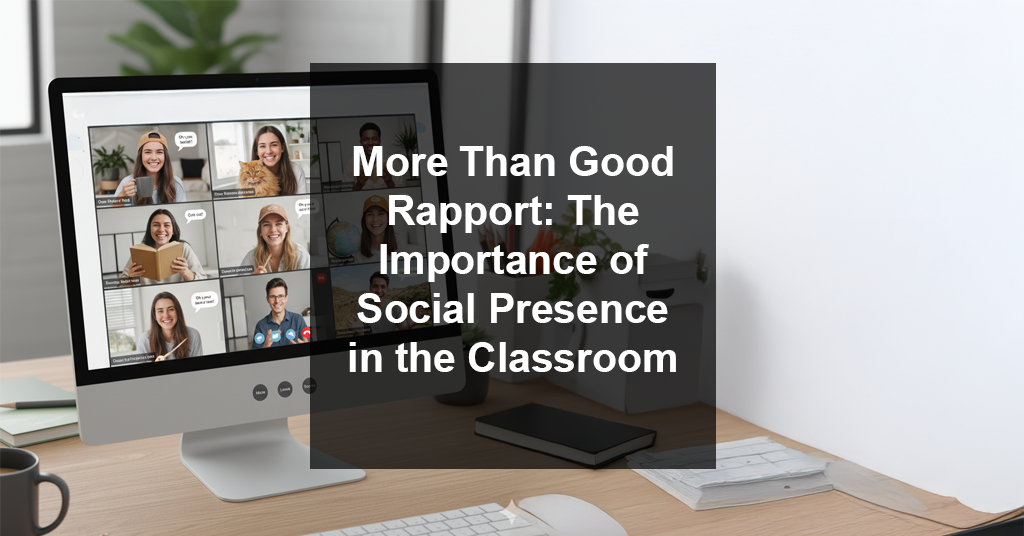Learn about what social presence is and why it matters for your in-person, hybrid, or virtual classroom.
Most instructors would say that they want their learners to have positive, collegial relationships with one another, but did you know that there are actually tangible benefits to fostering positive social presence in your course?
What is Social Presence?
Social presence is one of three related “presences” alongside teaching and cognitive presence that comprise the Community of Inquiry (COI) model developed by Garrison, Anderson, and Archer. This model provides a way to understand the learning experience within online environment, such as Canvas, the learning management system. The model examines the interplay of teaching, cognitive, and social presence in the space.
For this post, I will focus on social presence, which Boston et. al. describe as “the ability of learners to project themselves socially and emotionally as well as their ability to perceive other learners as ‘real people’” (2019). Simply put, social presence is how learners perceive their peers and how they want to be perceived by their peers.
It’s worth noting that this isn’t anything particularly unusual or unique to the educational setting. Any time we engage with one another socially, we’re contributing to how we would like to be perceived by others or how others are perceived by us. For example, I have a passion for the American Midwest (Indiana, especially) and a keen interest in gothic storytelling, and these interests often get expressed via the references I make, the information I share, the clothes I wear, the memes I post online, etc. When Stranger Things first came out, a popular media located at the intersection of these two things, I had friends who (correctly) identified it as something I would love—or, in their words, “very John-Carter-core.”
The primary difference between this and how social presence appears in an educational setting is that the classroom (virtual or in-person) is necessarily a more controlled environment. As instructors, we have a degree of control over things like discussion board topics, classroom activities, and other engagement opportunities that give learners opportunities to express themselves socially, which can have a significant impact.
Why is Social Presence Important?
Seeing the tangible significance of social presence can be difficult. Obviously, we would like our learners to have positive social interactions in the learning environment, but should this consideration carry as much weight as other curricular design concerns, such as classroom engagement, unit planning, or assignment design?
The short answer is: Yes!
The slightly longer answer is: Yes, because humans are social creatures, and how we feel about the relationships we have with others affects the way we engage in the spaces facilitating those relationships.
Social Presence and Persistence
First, social presence is valuable for learner persistence and retention. In Boston et al.’s 2019 study, examined COI indicator statements and learner re-enrollment, finding that out of all the social presence indicators, all but one were significant predictors for student re-enrollment.
More specifically, the researchers found that around 20% of the variance in student re-enrollment was accounted for by two indicators alone, both social presence indicators:
- Online or web-based communication is an excellent medium for social interaction (18% of the total variance)
- I was able to form distinct impressions of some course participants (2.2% of the total variance)
These two indicators are noteworthy because they are two of the three social presence indicators that focus on affective expression (how learners express themselves). This suggests that the way learners express themselves as full people and their ability to form similar impressions of their peers are both crucial to impacting how they persist in their educational journeys.
Social Presence and Cognitive Presence
Supporting learners’ social presence in the classroom helps support their cognitive presence at the same time. In Shea and Bidjerano’s 2009 study, they found that social presence is an important factor in learner cognitive presence. Like Boston et al.’s study, Shea and Bidjerano used 34 specific COI indicators phrased as statements to which learners indicated their level of agreement or disagreement using a five-point Likert scale.
The results of Shea and Bidjerano’s research suggest that the more comfortable and present learners feel socially, the more present they feel cognitively. Conversely, less comfort and social presence seem to be associated with a lower cognitive presence.
In the discussion of their study’s results, the researchers emphasize that helping learners “gain comfort and confidence in the online discussion format” is an essential component of fostering a strong cognitive presence in a course.
Want to learn more about social presence and how you can apply strategies in your own course? Ball State faculty can enroll in the Pillars of Effective Teaching Online self-paced course.
Conclusion
In education, there is a tendency to look for tangible, quantifiable metrics to indicate success—both in terms of learners’ success (e.g., grades, points, etc.) and the course/instructor’s success (e.g., learner attendance and retention, course eval ratings, etc.). Because of this, I think we tend to fixate on course elements that most obviously focus on or lead to these concrete metrics, rather than “softer” course elements such as the social relationships between learners. However, research shows that social presence isn’t just a consequence of a positive classroom environment—it’s a valuable component of a course’s design that leads to quantifiable outcomes, such as learner persistence and cognitive presence.
How have you considered social presence in your classroom? When preparing to teach, where does social presence fall on your list of priorities?
References
Boston, Wally, Sebastián R. Díaz, Angela M. Gibson, Phil Ice, Jennifer Richardson, and Karen Swan. ”An Exploration of the Relationship between Indicators of the Community of Inquiry Framework and Retention in Online Programs.” Online Learning (Newburyport, Mass.) 13, no. 3 (Feb 2019): 3-19. https://doi.org/10.24059/olj.v13i3.1657
Shea, Peter and Bidjerano, Temi. ”Community of inquiry as a theoretical framework to foster ‘epistemic engagement’ and ‘cognitive presence’ in online education.” Computers and Education 52, no. 3 (Apr 2009): 543-553. <a href="https://doi.org/10.1016/j.compedu.2008.10.007"https://doi.org/10.1016/j.compedu.2008.10.007



Comments: